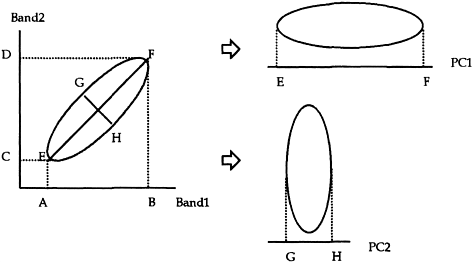293.
| [Cover] [Contents] [Index] |
Page 62
 |
(2.5) |
This is effectively a rotation of the axes of the feature space.
PCA has the property that the first principal component image (PC1, derived from the first eigenvector) represents the maximum amount of the total variance of the data set, and the variances of the remaining principal component images decrease in order, as denoted by the magnitudes of the corresponding eigenvalues. Normally, the variance contained in the last few principal components is small. Therefore, PCA is often used to condense the information in a multiband image set into fewer channels (represented by the higher-order components), and input them, rather than the raw data, into a classifier, thus reducing the computational demands and possibly improving performance. However, as noted already, there is no reason to assume that lower-order principal components do not contain any discriminating information. It may also be of interest to note that the locations of the principal component axes in the feature space are fixed by reference to two constraints. First, the axes are orthogonal. Second, each axis accounts for the maximum variance in the data set given that the influence of any higher-order components has been removed. Relaxation of the second constraint allows the use of orthogonal rotations that might make the resulting components more interpretable. It is also possible to relax the first constraint, but that does not seem to be helpful in the present context.
Figure 2.2 shows an example using a two-band image. Here, the original pixel values in the two images fall in the range [A, B] and [C, D], respectively. After the covariance (or correlation) matrix is formed, the resulting eigenvectors are orientated in the directions [E, F] and [G, H], respectively.

Figure 2.2 A two-band example for principal component analysis.
| [Cover] [Contents] [Index] |
EAN: 2147483647
Pages: 354